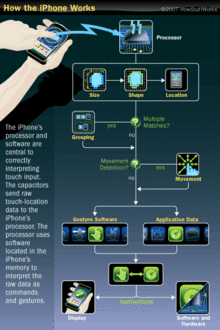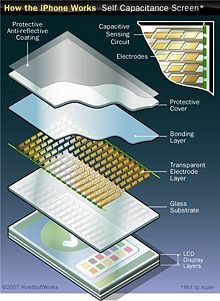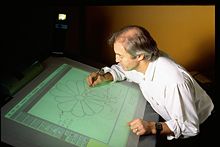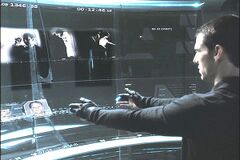Multi-touch interface
To provide students with experience in collaboration, you are warmly invited to join in here, or to leave comments on the discussion page. The anticipated date of course completion is 13 August 2010. One month after that date at the latest, this notice shall be removed. Besides, many other Citizendium articles welcome your collaboration! |
A multi-touch interface (or multitouch) is a human-computer interaction technique and the hardware devices that implement it, which allow users to compute without mechanical input devices (e.g., mouse, keyboard). After several decades of research by a number of different universities, companies, and research groups, multi-touch exploded onto the commercial scene with the release of Apple's iPhone in 2007. Now, multi-touch is becoming a standard feature in mobile phones worldwide.
Multi-touch consists of a touch screen (screen, table, wall, etc.) or touchpad, as well as software that recognizes multiple simultaneous touch points, as opposed to the standard touchscreen (i.e. computer touchpad, ATM), which recognizes only one touch point. This effect is achieved through a variety of means, including but not limited to: heat, finger pressure, high capture rate cameras, infrared light, optic capture, and shadow capture.
A myriad of different applications for multi-touch interfaces both exist and are being proposed. Some applications are focused on improving the interface for a single individual (e.g. iPhone, iPod touch, MacBook Pro, MacBook Air), however multi-touch technology is often used to incorporate collaboration into the computing experience (e.g. Microsoft Surface).
How does Multi-Touch Technology work?
Multi-Touch Technology (MTT) is a type of Human Computer Interface that’s grown in popularity since 2007 when Apple released the commercially successful iPhone. It was one of the first implementations of MTT that was targeted for the public at large. In MTT devices, the user interacts with the computer by touching and making gestures on a specialized touch-sensitive display surface that can detect multiple points of contact (touches) as well as gestures.
One of the major features to the technology is that the interface replaces a number of physical peripheral devices with a soft replacement (i.e. non-tactile) in a single self contained device, thereby increasing the portability and functionality of the device. Though the specific input interface varies amongst devices and applications, they usually include:
- A virtual, or soft, keyboard to allow the user to input text and numbers.
- Ability to simulate a mouse, by dragging a finger across the display.
- A number of gestures that have specific application functionality (i.e. the pinch which zooms in and out).
Generally, multi-touch devices share a similar architecture composed of three parts: the touch-sensitive display surface, controller and software drivers. The surface registers the touch event and sends the signal to the controller. The controller does the signal processing (filtering noise, determining pressure signature, and analog-digital conversion) necessary to compute the coordinates of the touch. The controller sends this data to the software which handles the event.
Touch-sensitive display surfaces supporting MTT can be implemented in a number of ways. Among them are capacitive, resistive, infrared, and surface acoustic wave sensing mediums. Here, I will only discuss capacitive and resistive which are the types of technology used in mobile phones.
Capacitive Touch Screens
Capacitance-sensing multi-touch screens are the most prevalent implementation behind multi-touch cell phones.[1]. There are a number of technologies within the capacitance-sensing family to detect multi-touch but, in smart phones, mutual capacitance sensing is the most dominant[1]. The technology works by having a capacitive material whose local electrical charge gets changed when touched by your finger (or any other conductive material).
According to Apple’s patent (US 7,663,607 B2), in Mutual capacitance there is an electrically conducting medium like Indium Tin Oxide (ITO) which is arranged in the following set up. The medium is in an array formed by two different layers. Driving lines form the first layer, and sensing lines, which usually run perpendicular to the driving lines, form the second layer. The driving lines are connected to a voltage source and the sensing lines to forming a capacitive sensing circuit. During a touch, the local electrical properties of the screen change and are detected by the nodes[2].
Perhaps the main limitation to this approach is that it can’t be used in situations where the user has to wear gloves. Another limitation is its expense. Limitations aside, it has a high-resolution, high-clarity, and is not affected by environment. It should be noted that on February 16, 2010 Apple was awarded a patent for capacitive multi-touch which covers two implementations: single and mutual capacitance (patent no, US 7,663,607 B2).
Resistive Touch Screens
Resistive sensing multi-touch screens are growing in prominence for several reasons:
- They allow the user to use gloves
- The technology is significantly less expensive
- The devices have lower power consumption than their peers.
Resistive multi-touch screens consist of two glass or acrylic panels that are coated with a conductive material like Indium Tin Oxide and are separated by a narrow gap. When the user touches the display, the conductive layers are connected establishing an electrical current which is then measured and processed by the controller. A limitation of this technology is that it is not as robust as its capacitive counterpart. Currently, attempts to add additional screen protection limit device functionality, significantly limiting the ruggedness of the device.
A brief history of Multi-Touch technology
There have been a number of significant inventions, dating back to the 1970’s, that have been instrumental in the development of multi-touch technology. The following section is adapted from a broad history of multi-touch already written by Bill Buxton, which is available on his website[3]. Buxton is considered one of the leaders in human computer interaction research, and his paper on the history of touch technology is frequently cited.
One of the first, and most significant, inventions relative to the creation of multi-touch technology was the development of a touch screen able to recognize a single touch. The first accepted example of this technology is the PLATO IV. PLATO IV was developed in the 1970’s by the University of Illinois Computer-based Education Research Laboratory. This device was a computer assisted educational device which recognized single touch, non-pressure sensitive inputs from the user[3]. The touch panel consisted of a 16 X 16 grid of sensors and infrared-light emitting diodes around the plasma panel, allowing the computer to identify from any of the 256 regions (Sherwood, 1972)[4].
In 1983, Myron Krueger completed a prototype of the VIDEOPLACE which allowed a user to interact with images on a vision based system via a set of predefined gestures. Though the system did not rely on touch, the significance of this work was that it was able to recognize a number of gestures, such as, pointing, pinching, and dragging[5].
In 1985, the first multi-touch tablet using capacitive touch screens was developed by the Input Research Group at the University of Toronto. This tablet was capable of sensing more than one point of contact at a time, determining their locations and measuring their degree of contact. The additional significance of this tablet, at the time, was its method of scanning user input and its ability to detect contact with a high degree of resolution[6].
In 1991, a multi-touch desktop display was developed that aimed to give the user’s desk and workspace the properties of an electronic workspace was developed by Rank Xerox EuroPARC. The significance of this project is that rather than using capacitive touch screens, it used a computer controlled camera in combination with a projector above it to sense the user input. In the set up, the camera detected the location of the user’s input and what they were pointing to. The projector displayed feedback and electronic objects onto the surface[7].
In 1992, IBM and Bell South released the first touch screen smart phone called Simon. The input depended on both stylus and touch replacing physical buttons with a virtual (or soft) keyboard on the screen. Simon’s functionality included that of a phone and a PDA. One of the limitations of this technology was that it could not differentiate pen contact from finger contact[8].
In 1997, the T3 was invented by Alias|Wavefront which allowed the user to use more gestures including navigating, panning, rotating, and zooming that responded quickly to the user input[9]. Additionally, the user could combine these basic movements to form more complex onesCite error: Closing </ref> missing for <ref> tag. This company was later bought by Apple who used FingerWorks designed technologies in their multi-touch devices.
In 2004, the first (commercially available) transparent multi-touch capable screen was released. This device, called the Jazz Mutant, was targeted towards musicians[10][3].
In 2007, two commercially successful multi-touch devices were introduced. These two devices were the Apple iPhone and Microsoft Surface. The iPhone was a smart phone that used multi-touch technology and was capable of detecting two points of contact simultaneously. The iPhone was also capable of recognizing basic gestures including, but not limited to, the pinch and swipe. This phone used a capacitive-sensing touch screen[11][3]. The iPhone was geared for the general public and was integral in making multi-touch technology ubiquitous. Microsoft Surface was a table surface able to sense multiple user touches and gestures simultaneously on a single surface. Because of its price of $14,000, it was geared towards corporations and institutions, where it was successful. Microsoft Surface used optical technology to detect input.[12].
Legal Issues in Multi-Touch
For copyright purposes, it would be convenient to say that multi-touch technology was invented by so-and-so, and that the rights belong to that person. Unfortunately, as with many cutting edge technologies, there is no single “inventor.” Mimicking 1976, when two independent groups came up with very similar ideas to solve the key-exchange problem, there were several different researchers and research groups working on multi-touch technology. Each of these researchers, or groups of researchers, approached the problem in a different, yet very similar, way.
In 1983, Myron Krueger was implementing and using the hand gestures we think of as commonplace today (pinching to zoom/scale and resize, etc.)[3] . Did Myron Krueger invent them? Nobody is really sure who came up with the ideas for these gestures; however, many of these research groups began to implement and use them in their own multi-touch implementations. When Apple Inc. released the iPhone in 2007, they concurrently submitted patents for many of the gestures, as well as the multi-touch technology that those researchers had been using for years. Could Apple really be the first company to take these technologies/ideas to the U.S. Patent Office? Did Apple infringe on any of these researcher’s/developer’s patents? The issued has not been settled.
As of mid 2010, there are a number of companies producing cellular phones with touch screens, and multi-touch screens. A number of these touch screen phones have begun to look more and more like the iPhone. In addition to looking like the iPhone, these phones also respond to many of the same gestures as the iPhone. The similarities in all of these different implementations was bound to result in some sort of litigation and, in the years since Apple’s release of the iPhone, there have been a number of legal issues regarding the multi-touch technology used by each of these phones. The following list of lawsuits is in no way a comprehensive list but is used to give the reader an idea of the type of legal issues that are currently being faced:
Apple’s Lawsuit: Apple vs. HTC
On March 2, 2010 Apple Inc. filed suit against HTC Corp. for violating more 20 of Apple’s Patents related to the iPhone and other Apple Products (U.S. Patent Numbers 7,362,331; 7,479,949; 7,657,849; 7,469,381; 5,920,726; 7,633,076; 5,848,105; 7,383,453; 5,455,599; 6,424,354; 5,481,721; 5,519,867; 5,556,337; 5,929,852; 5,946,647; 5,969,705; 6,275,983; 6,343,263; 5,915,131; and RE39,486)[13] . The patents listed in the lawsuit cover a wide variety of technologies including, but not limited to, touch screen command determination using heuristics, unlocking a device with a gesture, display rotation, camera power management, and signal processing. Many news and technology sources have speculated that this is more of a shot at Google/Android than it is at HTC. Though none of these patents are for multi-touch directly, many of them are for gestures and gesture based capabilities provided by Apple Technology. This court case has yet to see a courtroom.
HTC Counters: HTC vs. Apple
On May 12, 2010, HTC filed a countersuit against Apple Inc. citing 5 of HTC’s patents (U.S. Patent Numbers 6,999,800; 7,716,505; 5,541,988; 6,058,183; and 6,320,957)[14]. Only one of these patents (6,058,183) relates to multi-touch technology; however, the lawsuit probably would not have come about if the original lawsuit by Apple was not filed. This case, like the other, has yet to see a courtroom.
Elan Microelectronics files a complaint with ITC
On March 29, 2010, Elan Microelectronics (EMG) filed a complaint with the International Trade Commission over Apple’s use of multi-touch technology in just about all of its products. The patent in question is U.S. Patent Number 5,825,352: “Multiple Fingers Contact Sensing Method for Emulating Mouse Buttons and Mouse Operations on a Touch Sensor Pad”[15]. In EMG’s complaint, they have asked for a complete ban on the import of iPad, iPhone, iPod Touch, MacBook, and Magic Mouse[16] .
The Future of Multi-Touch
The possibilities for the uses of multi-touch are endless. Through the years we have seen futuristic versions of multi-touch in television and on the big screen; but when are those things going to be real for the rest of us? In this section I will mention a few sectors where I believe that multi-touch is going to have a big impact in the future.
Education
Most of us fondly recall the horrible sound of chalk squeaking on the chalk board, or the horrible smell of whiteboard markers from our days in school. What if we could eliminate white boards, black boards, etc. and replace all of them with multi-touch wall displays? While the initial outlay for such technology would likely be hefty, costs for consumable supplies such as chalk, markers, projection bulbs, erasers, etc. would be eliminated. In addition, the time to restock supplies or find shared projectors would be saved. In addition to being incredibly economical, these touch screen displays would provide teachers with improved functionality, responsiveness, and comfort. What teacher likes being covered in chalk day in and day out?
Military
In the world of the military, it is common for things like cellular phones, laptops, etc. to get roughed up. Military members may take their cellular phones or laptops out in the field because they are incredibly useful tools. Knowing full well that these “tools” may get damaged; however, military members are hesitant to buy technology such as the iPad/iPhone for use in the field. Anyone who has sat on their iPhone and listened to it crunch will agree that it is probably not a good idea to take such a device out into the field where anything can happen. Recently, companies have begun producing multi-touch technology that is more durable. For example, HP just has released a multi-touch enabled notebook that is “engineered to meet the tough MIL-STD 810G military-standard tests for vibration, dust, humidity, altitude, and high and low temperatures.”[17] As this type of durable technology becomes more available, military members will be more willing to spend their hard-earned money without fear of destruction. In addition to members of the military buying these products, governments will be more willing to issue devices like this for use by troops.
Health Care
Anyone who has been to a doctor’s office or hospital has seen the massive amount of paper and x-ray sheets that are used on a daily basis. These resources are not free, there has to be a cheaper way to view/read diagnostic images and patient medical histories. Tablet PCs and devices such as the iPad would be perfect for a complete overhaul of the system. Doctors could each have an iPad like device which he could download his patient’s medical history/x-rays/diagnostic images to and have all the information he/she needs in one place. In fact, this plan is already in the “testing” phase with a number of hospitals trying it out. According to John Halamka of Harvard Medical School, “the combination of lower hardware acquisition costs and relative lack of learning curve (since many people already have smartphones) could foster widespread adoption of the iPad in health-care settings and pave the way for electronic heath records to become the norm.”[18] If this idea catches on, it could save the healthcare industry millions of dollars and increase hospital efficiency significantly.
Pop Culture References to Multi-Touch
A lot of what we see in pop-culture actually shapes the way that technological trends go. When people see some type of new technology in a movie, it creates a demand for that technology. In the 2002 movie Minority Report, Tom Cruise used, what appeared to be, a curved glass computer that he controlled by wearing gloves and making gestures with his hand. Though Tom Cruise was not actually touching the surface, this is where many of us first saw "multi-touch" and what it might be capable of in the future. Today, on any given night, we can turn on the television to shows like CSI, NCIS, or Fringe and see them using multi-touch displays to scan through evidence or crime scene photographs. In addition to use in fictional television, these devices are used, today, by weathermen, ESPN (March Madness Selection Sunday), news reporters (2008 Presidential Election), etc. As the technology continues to progress, the world will see multi-touch being used in a plethora of different ways.
References
- ↑ 1.0 1.1 Williams, Andrew. “Touchscreen lowdown -- Capacitive vs. Resistive” Web. 4. Aug 2010<http://www.knowyourmobile.com/features/392510/touchscreen_lowdown_capacitive_vs_resistive.html >
- ↑ Hotelling, S, et al. Multipoint touchscreen. Apple Inc. assignee. Patent US 7,663,607 B2. February 16, 2010.
- ↑ 3.0 3.1 3.2 3.3 3.4 Buxton, Bill. "Multi-Touch Systems That I Have Known and Loved." Bill Buxton. Bill Buxton, 12 Jan. 2007. Web. 2 Aug. 2010. <http://www.billbuxton.com/multitouchOverview.html>
- ↑ Status of PLATO IV.
- ↑ VIDEOPLACE—an artificial reality.
- ↑ http://doi.acm.org/10.1145/1165385.317461 A multi-touch three dimensional touch-sensitive tablet.]
- ↑ The DigitalDesk calculator: tangible manipulation on a desk top display.
- ↑ Manual deskterity: an exploration of simultaneous pen + touch direct input.
- ↑ [ http://doi.acm.org/10.1145/258549.258574 The design of a GUI paradigm based on tablets, two-hands, and transparency.]
- ↑ < http://www.jazzmutant.com/behindthelemur.php >
- ↑ iPhone Design. Web 8 Aug. 2010. <http://www.apple.com/iphone/design/>
- ↑ What is Microsoft Surface. Web. 8 Aug 2010. <http://www.microsoft.com/surface/en/us/Pages/Product/WhatIs.aspx >
- ↑ Apple Inc. vs High Tech Computer Corp., A/k/a HTC Corp., HTC(B.V.I.) Corp., HTC America Inc., Exedea, Inc. The United States District Court For The District of Delaware. 02 Mar. 2010. Print.
- ↑ Krause, Kevin. "The Five Patents in Question in the HTC v. Apple Countersuit." Phandroid. 12 May 2010. Web. 3 Aug. 2010. <http://phandroid.com/2010/05/12/the-five-patents-in-question-in-the-htc-v-apple-countersuit/>
- ↑ Bisset, Stephen J., and Bernard Kasser. Multiple Fingers Contact Sensing Method for Touch Sensor Pad - Involves Indicating Simultaneous Presence of Two Fingers in Response to Indication of Two Maximum Peaks. LOGITECH INC (LOGI-Non-standard), assignee. Patent US5825352-A. 20 Oct. 1998. Print.
- ↑ Martin, Tim. "Cell Phone Multi-Touch Technology Lawsuits Continue." News Blaze. 7 Apr. 2010. Web. 3 Aug. 2010. <http://newsblaze.com/story/20100407135415tm75.nb/topstory.html>
- ↑ Hp. HP Unveils Ultra-thin, Touch-enabled Convertible Tablet and Notebook PCs for Small and Midsize Businesses. News Release. Hp, 1 Mar. 2010. Web. 3 Aug. 2010. <http://www.hp.com/hpinfo/newsroom/press/2010/100301xa.html>
- ↑ White, Martha C. "The Essential Source for Business and Economic Policy News Post Politics More From The Big Money » With the iPad, Apple May Just Revolutionize Medicine." The Washington Post. 11 Apr. 2010. Web. 3 Aug. 2010. <http://www.washingtonpost.com/wp-dyn/content/article/2010/04/09/AR2010040906341.html>




